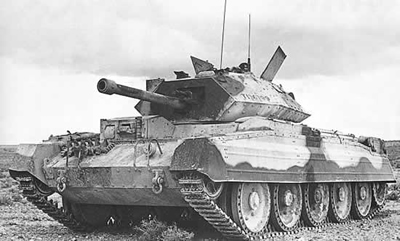The Second Battle of El Alamein is considered a turning point in World War II.
After the Battle of Alam el Halfa, the British were left in an advantageous position.
Axis forces were low on armored reserves and low on fuel. Supply lines were very long, and armored units had to be broken up so they did not have to make long drives.
The British, on the other hand, had large reserves of replacement tanks.
In addition, having learned from earlier mistakes, the British had reorganized their armored formations so that command was more centralized.
An armored division now had contained an armored brigade and a motorized infantry brigade (which in some cases was replaced by a second armored brigade). Supporting regiments included two artillery regiments, an anti-tank regiment, an anti-aircraft regiment and an armored car regiment.
 On the evening of October 23, 1942, Montgomery went on the offensive, feinting in the south while his main force struck in the north. Tanks, artillery and infantry worked together smoothly.
On the evening of October 23, 1942, Montgomery went on the offensive, feinting in the south while his main force struck in the north. Tanks, artillery and infantry worked together smoothly.
Although Rommel’s forces had put down complex minefields, the British were able to get through these by the morning of October 25.
They then defeated counterattacks by German and Italian forces.
By early November 2, the British had about 800 tanks, while Rommel had less than 100. Nevertheless, Axis anti-tank defenses were so strong that Axis forces were still able to inflict heavy casualties on the British.
The British 9th Armoured Brigade was ordered to break through Axis defenses. It was able to break through the German infantry, but was then attacked by panzers, which were able to destroy almost all of the 9th Armoured Brigade’s tanks.
Afterwards, the 1st Armoured Division pushed through the gap and took up defensive positions.
It held its own, despite being attacked by German forces on both sides.
By the end of the battle, Rommel’s Afrika Korps was left with only 24 tanks.
Rommel then requested that his troops be allowed to withdraw, but Hitler insisted that he hold the position.
The Afrika Korps was able to stop two attacks at Tel el Aqqaqir.
However, the Axis forces were then flanked by infantry forces, supported by tanks. They divided the Africa Korps from the Italian divisions on its flank. British tanks then rushed through the gap.
Rommel was then forced to retreat, regardless of Hitler’s wishes.
The Germans left some of their tanks behind, because they did not have enough fuel for them. In the end, they were left with only 10 tanks.
By the middle of November, Rommel had reached El Agheila in Libya. He was provided with reinforcements, so that he had 36 German tanks and 57 Italian tanks at his disposal. He then retreated to southeastern Tunisia.